Santos is committed to minimising the environmental impacts of our operations and activities, and to work with our communities and partners for positive environmental outcome.
The size, nature and complexity of Santos’ operations pose a range of environmental risks when carrying out exploration and production activities. Proactively and effectively managing environmental risks and adhering to regulatory requirements, including environmental licences or plans, is crucial. Failure to adequately manage these risks may result in environmental incidents and regulatory non-compliance. These consequences can lead to regulatory action, delays, disruption or the shutdown of exploration and production activities, and loss of Santos’ licence to operate.
We take steps to minimise environmental impacts on local ecosystems. This includes habitat restoration and careful monitoring to assist compliance with environmental regulations. We include measures to protect groundwater and minimise usage through recycling and advanced management techniques.
Santos has established protocols and technologies to both prevent spills and mitigate incidents that could impact the environment. Additionally, Santos applies a learning approach to proactively drive continuous improvement in environmental management practices.
Our approach
Santos takes a comprehensive and structured approach to managing environmental risks. Ensuring the environment is at the forefront of all our activities each and every day, the Santos Management System (SMS) describes how we manage, monitor and evaluate environmental compliance and achieve our environmental objectives.
The SMS outlines the processes and requirements that guide how we operate across all assets and functional support teams. It provides a consistent framework of policies, standards, procedures, and tools to support environmental risk management, compliance and the achievement of our environmental objectives. The SMS integrates technical and engineering requirements with environmental requirements, in order to comprehensively manage environmental risks within operations.
The SMS applies to all personnel and is aligned with ISO 14001, the internationally recognised standard for environmental management systems. This alignment ensures our practices meet global benchmarks for environmental performance, risk management, and continuous improvement.
Read more on our sustainability governance approach and the SMS here.
The SMS defines the minimum environmental standards that the business must achieve across a range of aspects including:
- Waste management
- Water sourcing and management
- Biodiversity management, including pest plant and animal management
- Land, seabed and benthic habitat disturbance and rehabilitation
- Discharges to the environment
- Air and noise emissions, and
- Artificial light emissions.
The Environment Management Technical Standard, and supporting procedures, processes and tools, detail the technical requirements or specifications that must be achieved in a consistent manner. Key elements include:
- Risk management
- Compliance
- Management of joint ventures
- Management of contractors and suppliers
- Assurance
- Monitoring and reporting, and
- Continuous improvement.
Policy
Santos’ Environment Policy establishes our commitment to minimise our environmental impact. The Policy ensures environmental management is integrated in the way we work and that environmental considerations are included in our business planning and decision-making processes.
The Environment Policy applies to employees and contractors as defined in the Santos Code of Conduct and is implemented through inductions and training.
Environmental risk management
Santos takes an enterprise approach to risk management and operates under one Risk Management Framework for all risks, including environment-related risks. Our Risk Management Framework requires the identification and management of risks to be embedded in business activities and provides requirements and guidance on the tools and processes to manage risks. This enables risks that threaten the delivery of our Vision, Purpose and objectives to be effectively managed, including those related to the environment.
We manage, monitor and evaluate environmental compliance and achieve our environmental objectives, setting out our commitment to:
- Set, measure, review and monitor objectives and targets to demonstrate proactive risk reduction processes are in place and support a continuous improvement approach to managing environmental impacts
- Work proactively and collaboratively with our stakeholders and local communities to maintain our licence to operate and deliver positive environmental outcomes such as the beneficial reuse of process water for environmental and agricultural applications
- Ensure that activities comply with all legal obligations by understanding and managing our environmental compliance obligations, including securing and fulfilling all regulatory approval requirements, and
- Manage environmental impacts by minimising waste and enhancing biodiversity outcomes. Where impacts are unavoidable, we seek to offset them through targeted measures that protect and enhance environmental values, including land and biodiversity.
We are committed to reducing environmental impacts of our activities to as low as reasonably practicable and acceptable by applying a whole-of-life cycle decision making framework to effectively manage environmental risks throughout all stages of our activities. To minimise the environmental impact of our operations, we identify, assess and control environmental risks in accordance with the SMS, undertaking environmental risk identification or environmental impact assessment prior to the commencement of, and throughout the lifecycle of activity.
Awareness of environmental risks and controls is maintained across all regions and all levels of the business via regular reporting and leadership meetings, environmental professional forums, and general awareness programs communicated broadly. We ensure all workers are trained to understand the impacts of Santos’ activities on the environment including practices to reduce waste and efficiently manage water and energy.
We work in partnership with regional, national, and international industry groups – including Australian Energy Producers (AEP), Commonwealth Scientific and Industrial Research Organisation’s (CSIRO’s) Gas Industry Social and Environmental Research Alliance (GISERA) and the Centre of Decommissioning Australia (CODA) – to proactively monitor and address emerging environmental issues.
The SMS undergoes periodic internal audit assessments on a risk basis. Santos has three layers of assurance:
- Level 1: site level checks and inspections, including environment workplace inspections
- Level 2: site and regional level processes, including environmental assurance plans
- Level 3: independent assurance of the region or function, including functional assurance of Environment Management Technical Standard requirements across business activities.
Learnings from these assurance events drive improvement actions across Santos, our regional business units and individual assets, and are reflected in our SMS.
Our material topics
We have developed a structured approach to the closure and decommissioning of assets, reflecting best practices in environmental management, safety and community engagement.
Our approach
Decommissioning is the final part of the asset life cycle.
Our approach is to have a decommissioning plan that addresses our obligations, including regulatory and sustainability requirements. We have a set of standards embedded in our SMS that govern the decommissioning of the oil and gas assets where we operate. These standards enable us to fulfil our environmental and social obligations during decommissioning.
Repurposing of assets is also part of our broader commitment to sustainability and responsible resource management.
We take a phased approach across an asset’s decommissioning project lifecycle:
- Planning for decommissioning or repurposing
- Decommissioning assets or repurposing assets, and
- Site monitoring and rehabilitation.
Key programs and initiatives
We continue to engage with communities in the regions where we operate. In 2024, this included our engagement process for decommissioning the Campbell facility as part of our Asset Removal Operations Environment Plan.
We collaborate with industry bodies such as the Centre of Decommissioning Australia (CODA) and we are part of its Industry Advisory Committee to help shape the future of decommissioning for the oil and gas industry in Australia.
In 2024, we successfully completed several decommissioning projects:
- Campbell platform topside and substructure removal and disposal
- Harriet Joint Venture project completed 13 wells plug and abandonment (P&A), and
- Mutineer Exeter Plug and Abandonment project completed multiple wells P&A.
In addition to our full field decommissioning activities, we also undertook progressive decommissioning for our onshore assets. For example, in the Cooper Basin, we decommissioned five per cent of expired wells in compliance with local regulations. Additionally, we plugged and abandoned one well in Papua New Guinea.
For our non-operated assets, we supported the completion of the nine-platform removal on the Thevenard project and completed over 140 well plug and lower abandonment projects on the Barrow Island Decommissioning project.
Read more on risks and opportunities, our process and due diligence and our actions and performance in the 2024 Annual Report.
Case study
Campbell platform decommissioning
Production on the Campbell platform offshore Western Australia ceased a number of years ago.
Faced with an aging asset, Santos, in partnership with contractors, devised a way to remove the structure in three sections.
For removal of the first platform section, rope access technicians worked safely to prepare the site and cut the topsides from the monopod (the structure supporting the platform topsides). Using remotely operated underwater vehicles, subsea diamond wire cutting then separated the upper monopod section from the lower substructure (the part of the platform connected to the ocean floor). For the third and final section, the three piled legs were cut above the seabed, allowing for the lower section to be removed.
All platform sections were recovered using a crane on a large offshore construction vessel, then a barge holding the materials was towed 1,500km via tug to Henderson, Western Australia.
As part of Santos’ commitment to improve waste recycling across our operations, 99.5 per cent of the recovered platform was recycled – 930 tonnes of material – through local Western Australian facilities.
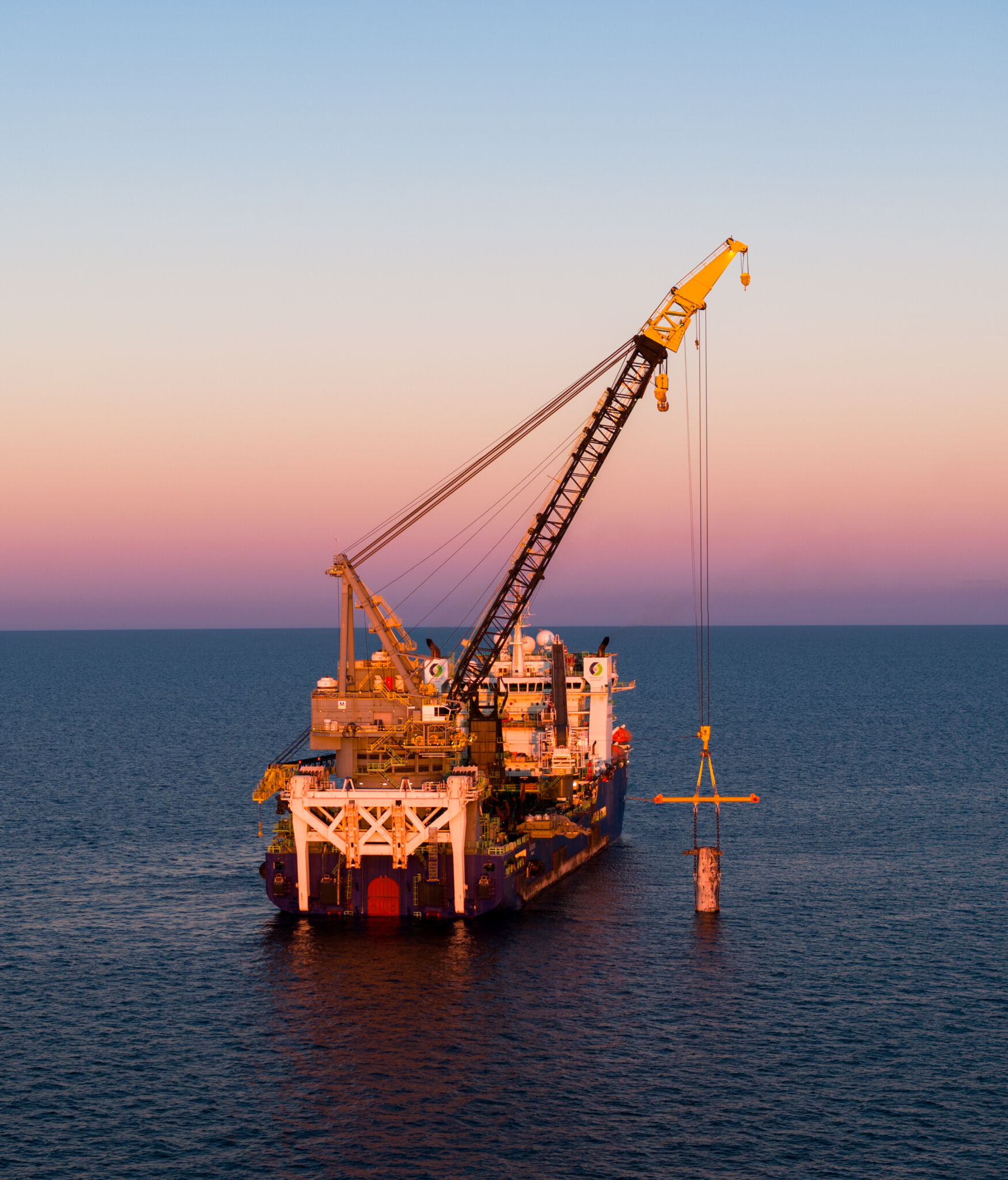
Decommissioning of Campbell Platform, offshore WA
Santos is dedicated to sustainably managing impacts to water resources from our activities. We do this through continuing to understand our water-related risks and applying the water management hierarchy across all our operations.
Our approach
Our activities seek to avoid and reduce water abstraction by ensuring operations maximise efficiency and avoid unnecessary consumption. When oil and gas is produced to the surface it is accompanied by water, known as produced water. Our aim is to maximise the reuse of this produced water.
Beneficially using produced water minimises dependency on other water sources and avoids residual water volumes that need to be otherwise managed, reducing impacts and costs across the full operating lifecycle.
In 2023, we embedded standardised water reporting requirements aligned to Global Reporting Initiative (GRI) 303: Water and Effluents 2018 to enable consistent monitoring, recording and analysis of water data across all our operations. Implementation of these procedures has resulted in the collection of consistent water data enabling our operations to maximise efficiency and avoid unnecessary consumption.
Our water performance reporting tracks water generated volumes by source (surface water, groundwater, seawater, produced water and third-party water), quality (fresh and other water) and discharge destination (surface water, groundwater, seawater, injection, beneficial use, evaporation and provision to third parties).
We then use this detailed information to inform and support management of water-related risks and opportunities via implementation of the water management hierarchy.
We seek to maximise beneficial reuse and recycling of produced water where possible, only releasing water to the environment in accordance with strict operating conditions.
- In offshore Australia and Papua New Guinea, most produced water is re-injected into depleted hydrocarbon reservoirs, reintroducing it into subsurface formations that replicate its original geological context. This approach minimises ecological impact and upholds sustainable resource management principles.
- In onshore Australia, regulatory frameworks permit the controlled release of produced water at three designated sites within Queensland: Jackson and Naccowlah in the Cooper Basin, as well as the Dawson River in the Bowen Basin. The total volume of released water in 2024 was 1,607 megalitres, a reduction from 2023 and 2022 volumes.
In Australia, we are reducing our impact on community water resources by funding initiatives to return water to the Great Artesian Basin.
Performance
To minimise our environmental impact, Santos aspires to maximise beneficial use of produced water from our operations.
In 2024, we beneficially reused 9,082 megalitres of produced formation water. Reuse activities included irrigation and stock watering, dust suppression, drilling and completions and civil works. This is an increase of 290 megalitres from 2023, 1,358 megalitres from 2022 and 3,486 megalitres from 2021.
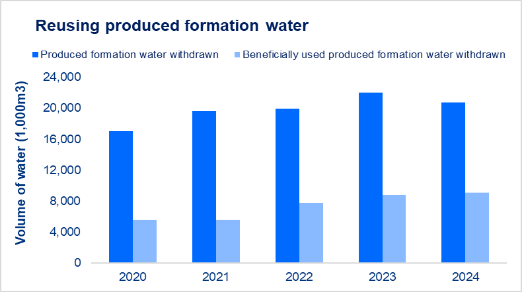
To minimise our environmental impact, Santos aspires to minimise freshwater consumption from our operations.
Santos’ total freshwater consumption for 2024 was 1,066 megalitres.
Our total water consumption (freshwater and other water) in 2024 was 1,909 megalitres, down from 3,960 megalitres in 2023.
Key programs and initiatives
Santos is committed to achieving net-zero abstraction of water from the Great Artesian Basin by offsetting our groundwater use through the funding of water-saving initiatives.
In Australia, the Great Artesian Basin (GAB) is a vital water source for many communities in the areas where we operate. We are committed to offsetting our groundwater abstraction from the GAB through the funding of water-saving initiatives. Over the past three years, Santos has invested A$3m in projects under a GAB Industry Partnership Program with the Queensland Government, which has resulted in water savings for the GAB’s aquifers. In 2024, our total gross water extraction from the GAB was 1,234 megalitres, offset by return of 3,005 megalitres.
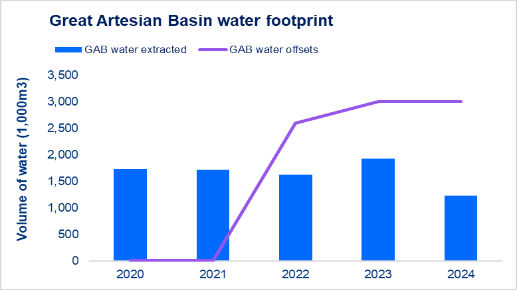
We have established irrigation projects at our Roma and Fairview operations in Queensland to reuse produced water extracted from coal seams. These projects generally involve pivot irrigation of forage crops and in Fairview, drip irrigation of a locally adapted native tree species, mainly Chinchilla White Gums.
Our irrigation projects accounted for more than 90 per cent of total produced water beneficial use in 2024. The irrigation projects have successfully established more than 600 hectares of high quality grass and legume pastures for cattle forage. Additional information relating to the strategies and procedures we maintain to responsibly and safely manage produced water and to monitor the surface water and groundwater in the areas where we operate can be found in the Santos Water Portal.
Case study
GLNG amine wastewater reduction
The GLNG amine wastewater reduction initiative eliminates approximately 240 kilolitres of wastewater per year, reducing Santos’ environmental footprint and waste disposal costs.
In 2022, Santos teams were challenged to identify initiatives to drive down our total volume of waste produced. At this time a project had been sanctioned to install new infrastructure to discard wastewater to the Gladstone trade-waste system.
One of our GLNG engineering teams took the initiative to test the need for the new infrastructure and identified a solution that would virtually eliminate wastewater production altogether. The team was successfully able to reuse the wastewater back into the facility’s acid gas removal plant, which is the source of most of the wastewater.
Key to the success of the project was the collaboration across a wide range of teams, including panel operators, operations specialists, senior engineers, and from third party amine consultants. This project is an example of the Santos team’s strong focus on building a better future and protecting the environment.
Read more on risks and opportunities, our process and due diligence and our actions and performance in the Santos 2024 Annual Report.
Our water data can be found in the Santos Sustainability Data Book.
Santos works across a broad range of terrestrial and marine environments from tropical and arid to polar biomes, each with its own unique and dynamic biodiversity. We aim to minimise our impact wherever possible.
Our approach
At Santos we acknowledge that there are potential biodiversity impacts from our developments and operations. To minimise our impacts, we implement structured development processes that follow an avoidance hierarchy (avoid, minimise, offset). We work collaboratively with our stakeholders to ensure the best biodiversity outcomes are achieved. Where we cannot avoid a biodiversity impact, we offset these impacts by protecting larger areas with similar biodiversity values.
In 2025, we published our new Environment Policy. This policy commits Santos to not undertake new exploration activities within the boundaries of natural sites on the World Heritage List (as specified on 19 August 2025).
The potential impact from our developments and operations on biodiversity varies by activity, depending on its scale, nature, and location. As a result, biodiversity assessment and management is tailored to each activity and project.
Santos conducts biodiversity impact and risk assessments across new and existing operational sites in line with regulatory requirements, which include criteria and processes defined by authorities.
Biodiversity risk assessment process steps vary by jurisdiction and may include:
- Literature review of previous ecological impact assessments, flora and fauna surveys and research studies in both project and adjacent areas
- Conducting surveys for flora and fauna
- Analysis of biodiversity datasets and mapping
- High resolution aerial photography and light detection and ranging (LiDAR) to investigate vegetation cover, landscape features and disturbance patterns
- Searching databases and maps for threatened species and populations, and
- Consultation and collaboration with local communities.
Performance
In 2023, Santos received the final approval from the Queensland Government for our Mount Tabor biodiversity offset project, formalising our partnership with the Bidjara people from southwest Queensland.
In a first for Santos’ Indigenous partnerships programs, this approval means the rich environment that covers over 5,000 hectares in southwest Queensland will be conserved, in partnership with local Traditional Owners.
Now formalised and with full Commonwealth and Queensland government approval, the partnership will allow for the regeneration of native vegetation and the development of ecological habitat to support a broad range of native and threatened fauna species, providing biodiversity offsets for GLNG over multiple years of development in the Fairview field.
To support our biodiversity risk assessments, in 2024, we completed a screening assessment using the Integrated Biodiversity Assessment Tool (IBAT) for our operational assets at a site, facility or tenement scale, in alignment with GRI 304: Biodiversity 2016. The IBAT assessment allowed us to identify International Union for Conservation (IUCN) Red List Threatened Species potentially occurring in proximity of our sites. In addition, we were able to identify, and map protected areas as documented in the World Database on Protected Areas as well as key biodiversity areas (KBAs) as documented in the World Database of KBAs in proximity to our sites.
This valuable information will enhance our assessment of potential impacts of activities on protected areas as well as inform management and protection for new developments.
Our risk assessments to date have not identified any sites that have had a significant biodiversity impact or are in proximity to critical biodiversity sites. Santos has controls and monitoring in place and some of these initiatives and programs are outlined below.
Key programs and initiatives
Case study
Lake Kutubu monitoring
Since 2010, we have been collaborating with the Lake Kutubu Wildlife Management Area Committee in Papua New Guinea to monitor and implement environmental improvement initiatives. The program was disrupted in 2018 by a devastating earthquake and again between 2020 and 2022 due to the COVID-19 pandemic. After consulting with the Committee, we resumed monitoring in 2023, and the program continued in 2024.
The 2024 monitoring program included assessments of hydrodynamics and sediment quality, a fish survey, snorkel survey, hydroacoustic data collection, villager questionnaire and catch landing survey.
Key findings from the program include:
- Fish biomass showed a general increase compared to previous studies
- Two native fish species were documented after an absence of more than 14 years
- Nine of the 12 species endemic to the region were observed or recorded in the surveys, and
- The abundance of exotic fish decreased to levels similar to those in 2014.
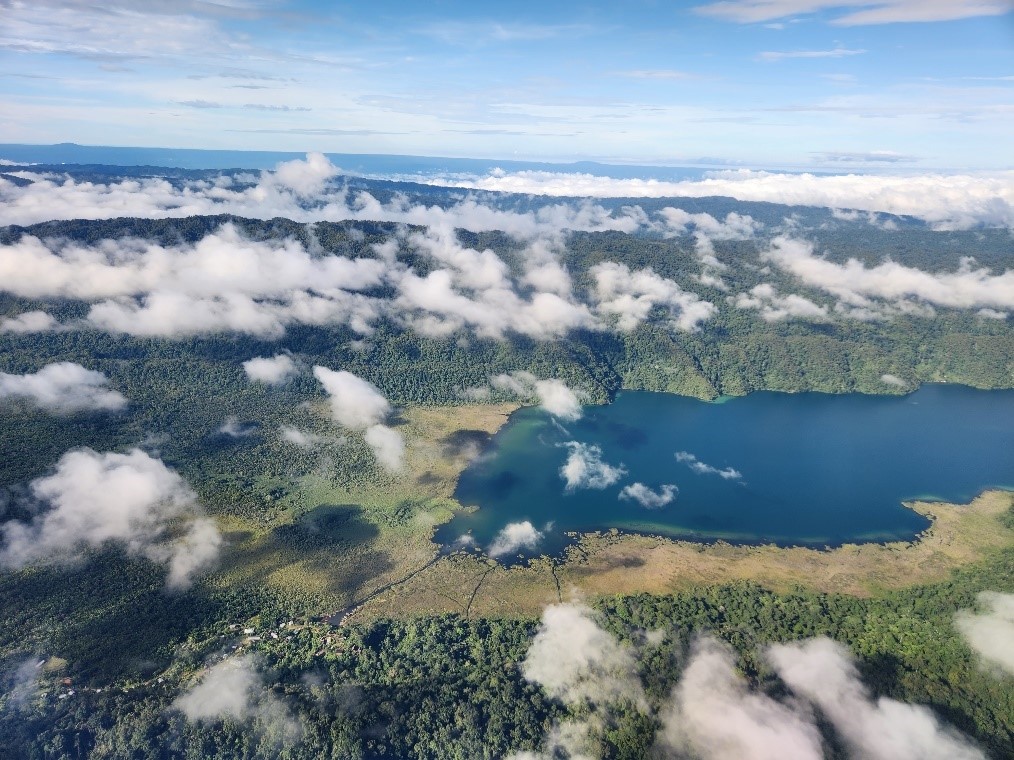
Lake Kutubu, PNG
Case study
Curtis Island long-term turtle management plan
For nearly a decade, Santos and its partners have worked to safeguard marine turtles in Gladstone Harbour and set a new benchmark for industry-led environmental stewardship through the Long-Term Turtle Management Plan (LTTMP), with collaboration being at the heart of this initiative.
The LTTMP includes an assessment of risks, development of mitigation strategies and associated monitoring tasks, focussed on Port Curtis, Curtis Island and Facing Island areas, as these are the locations where environmental risks to marine turtles associated with the Curtis Island liquified natural gas developments were considered the highest.
The Curtis Island program supported by Santos GLNG in conjunction with our Curtis Island neighbours, Shell and ConocoPhillips, and leading environmental consultancy Eco Logical Australia, has delivered crucial insights into turtle populations, behaviour, and habitat use, providing a roadmap for future conservation efforts far beyond the three LNG operations.
By increasing knowledge, improving conservation methodologies, and setting a new standard for marine turtle protection, this collaboration has left an enduring legacy for both the environment and future generations.
The project recently won the Australian Energy Producers (AEP) Excellence Awards, winning the Environment Project Excellence Award category as well as the prestigious Chair’s Award at the 2025 AEP Awards in Brisbane.
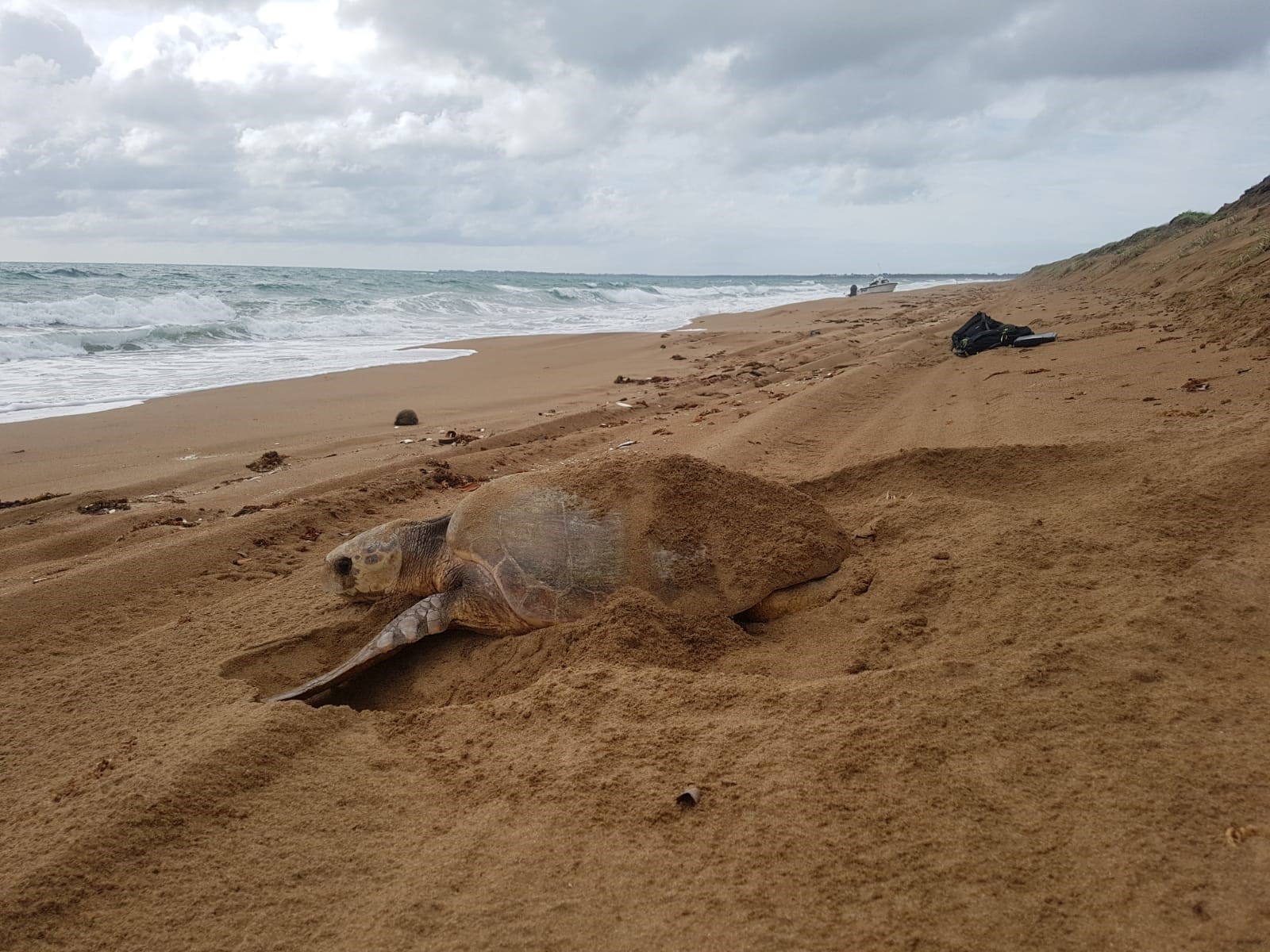
Curtis Island, Gladstone
In 2025, we will develop a framework to identify and evaluate nature-related dependency and impact risks to improve our understanding and management of our biodiversity risk profile.
Read more on risks and opportunities, our process and due diligence and our actions and performance in the Santos 2024 Annual Report.
Our biodiversity data, including information obtained from IBAT, can be found in the Santos Sustainability Data Book.
Important topics
Our approach
Our activities seek to avoid and reduce air emissions to prevent or minimise our impacts on nature. We acknowledge the importance of managing air quality impacts associated with nitrogen oxides (NOₓ) and sulphur oxides (SOₓ), volatile organic compounds (VOC) and particulate matter in the context of our operations and projects.
For information on our approach and management of greenhouse gas (GHG) emissions, refer to the Climate Report.
Key programs and initiatives
Santos has robust environment management standards that outline our minimum mandatory requirements. Aligned to the plan-do-check-act cycle in the ISO 14001 environmental management system standard, the environment standards form an integral part of the SMS to manage risks and minimise harm to the environment. These are monitored and assured by our integrated assurance program to check for compliance, effectiveness and continuous improvement.
Santos conducts air impact and risk assessments across new and existing operational sites in line with regulatory requirements. This includes air dispersion modelling to assess potential impacts of air emissions. We monitor and control air emissions from our activities ensuring that emissions remain within legally required limits.
Key initiatives include:
- Emission control technologies
- Monitoring and reporting, and
- Operational efficiency and innovation
These initiatives reflect Santos’ commitment to responsible environmental stewardship and its efforts to minimise operations air emissions environmental impact.
Our air quality data can be found in the Santos Sustainability Data Book.
Our approach
Waste management continues to be a focus throughout all operations via the implementation of long-term strategies that focus on the life cycle management of waste. As recycling and waste recovery programs advance, Santos has focused on waste avoidance, maximising reuse and improving recycling and recovery rates.
Our environmental management framework requires consideration of waste management, inclusive of legal requirements, risk management, treatment and disposal methods for our operations. The continued application of the waste hierarchy has been key to the improvement of waste management at each asset.
In 2022, we embedded standardised waste reporting procedures aligned to GRI 306: Effluents and Waste 2016 to enable consistent monitoring, recording and analysis of waste data across all our operations. Implementation of these procedures has resulted in the collection of consistent detailed waste data enabling our operations to track and proactively manage waste in accordance with the waste management hierarchy.
Our waste performance reporting tracks waste generated volumes by stream, hazardous/non-hazardous categorisation, by waste disposal outcome (disposal, disposal to landfill, recovery, preparation for reuse, recycling, injection and incineration) and location (on-/off-site management).
In partnership with our waste management contactors, we regularly complete Level 1 assurance on our waste management facilities, including visits, checks and inspections. We also facilitate routine regulatory inspections of these facilities. Through these efforts we continue to promote initiatives to avoid waste generation and promote recycling and reuse activities. Waste streams we typically generate from our activities include drilling fluids, general waste, scrap metal, chemicals and plastics. Comprehensive waste data, including waste composition, can be found in the Santos Sustainability Data Book.
In recent years Santos has executed the waste management procurement strategy, engaging Cleanaway Waste Management as our key waste management service provider in the Cooper Basin and Eastern Queensland and North West Alliance in Western Australia.
In support of our approach on waste management, we implement regular training, communications and education to drive correct waste management practices. In the Cooper Basin and Eastern Queensland operations, these efforts now culminate in an annual Recycling Champions of the Year Awards. In 2024, our contractor Global Engineering won the Cooper Basin Recycling Team of the Year Award.
Performance
To minimise our environmental impact, Santos aspires to avoid and minimise waste generation, and maximise recycling and recovery from our operations.
Waste performance is monitored through assurance activities at all points along the waste management process. Inspections at our waste management facilities are conducted to ensure appropriate management of waste in accordance with approvals and regulations. Performance monitoring is undertaken for all Santos operations.
In 2024:
- Of the total waste generated in Australia, 65 per cent was Diverted from Disposal (90 per cent in 2023 and 70 per cent in 2022)
- Of waste considered hazardous, approximately 68 per cent was Diverted from Disposal globally, and
- The percentage of waste diverted from landfill as of total waste generated was 76.1 per cent globally.
From 2023 to 2024, we observed an increase in total waste volume generated, primarily driven by expanded development and drilling activities in our Alaskan and eastern Queensland operations.
Testament to our aim to improve recycling rates, is the Campbell platform decommissioning project (refer decommissioning case study) where 99.5 per cent of the recovered platform material (930 tonnes) was recycled through local Western Australian facilities.
Our waste data can be found in the Santos Sustainability Data Book.
Key programs and initiatives
We continuously strive to implement key programs and initiatives to support our environmental commitments and aspiration to improve waste recycling and recovery year on year from our operations:
- Improving waste management in Papua New Guinea continues to be a focus. Key to this is concentrating on waste avoidance including reduction of packaging, source segregation, and on-site treatment and reuse, including enhanced biodegradation of organics in the HotRot[1].
- As our Pikka Phase 1 Project in Alaska progresses, initiatives to minimise the generation of waste continue to be explored, including beneficial reuse of materials generated during drilling and development activities.
Case study
Cooper Basin waste minimisation project
Commencing in 2020, the Cooper Basin waste minimisation project continues to transform waste management from disposal to avoidance, recovery and recycling. A cross-functional team including personnel from operational support and logistics, operations, environment and contractors was established to deliver the project, committing to driving lasting step-changes in the management of waste in the Cooper Basin through practical and behavioural improvement initiatives.
In the early days, focus areas included:
- Making changes to camp food packaging and eliminating single-use plastics
- Education campaigns promoting the lifecycle of waste streams recovered and recycled, and
- Identifying innovative opportunities for reuse, such as partnering with two small South Australian businesses who are re-purposing single-use pallets to produce custom-made garden beds and furniture.
In 2021, the project focused developing and implementing waste initiatives to divert substantial volumes of resource from landfill, including a dedicated shredding, reuse and recycling campaign in Moomba to process waste.
The shredder, in conjunction with other specialised demolition equipment, was used to process approximately 2,000 tonnes of recyclable material including pallets, tyres and bulk containers. Recyclable volumes were reduced by 60-70 per cent and where possible, the resulting material was identified for beneficial re-use. In one great example of this, 100 per cent of pallets shredded were used as stabilising material for projects being undertaken in Moomba.
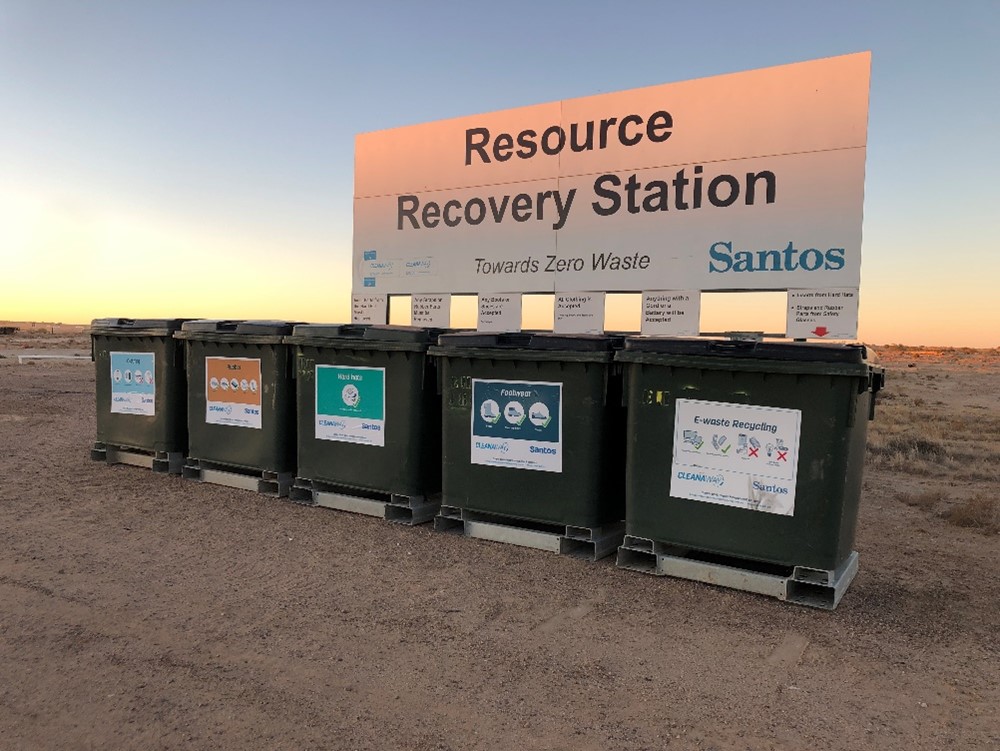
Cooper Basin
In 2023, the team introduced a reusable lunch container program across the Cooper Basin. This initiative has helped to eliminate over 80,000 lunch containers from being disposed. Santos and contractor field personnel have been issued with a lunch box set that includes a cooler bag, reusable ice packs, microwave safe containers and cutlery. Industrial grade dishwashing facilities have been installed to ensure containers remain hygienic.
Visitors to the Cooper Basin are also provided with reusable lunchboxes now that disposable containers are no longer available at field sites.
And again in 2023, our Cooper Basin operations commenced the final step towards removing disposable coffee cups from our camps and operations, distributing reusable cups to employees and contractors. Prior to the initiative, the Cooper Basin operations disposed over 350,000 coffee cups each year. This initiative is now being rolled out across our other areas of operation.
[1] Global Composting Solutions Ltd (HotRot) is a New Zealand-based business providing waste treatment solutions for customers with complex organic waste streams. HotRot designs, builds, installs and commissions integrated Organic Waste Treatment Plants around the proprietary HotRot Technology
